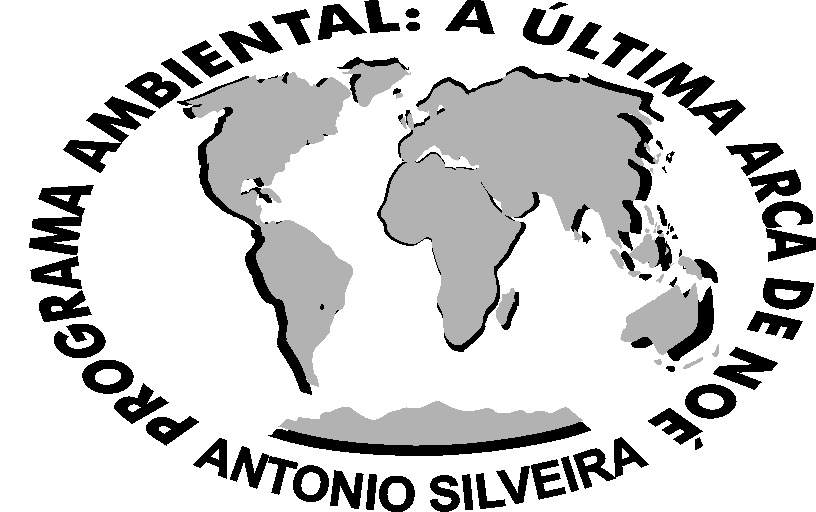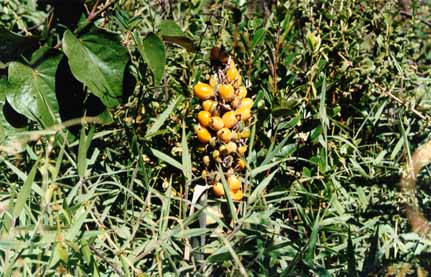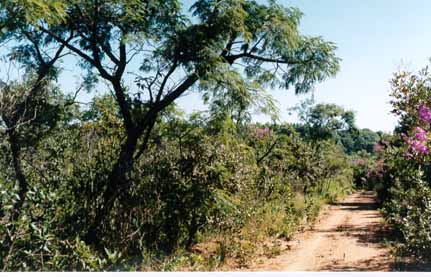
BRAZIL'S ECOSYSTEMS

BRAZIL'S ECOSYSTEMS
CERRADO (SCRUB)


Definition and relevant aspects
Cerrado is formed by vegetal formations of variable aspects and physiognomy, mainly of small and twisted trees that become covered to an exuberant creeeping plants.
It is originally around a quarter of Brazilian territory and it is one of the richest ecosystems of the Earth.
Total Area: 2.100.000 km2
Human Occupation: 700.000 km2
Its nuclear region with 150 million km2 is situated in the Brazilian Planalto Central, being extended by the States of Goiás, Tocantins, Distrito Federal, part of Minas Gerais and Bahia, Mato Grosso and Mato Grosso do Sul and part of Maranhão, Piauí and Rondônia (SMA/SP,1997).
By being unknown, it was very explored, giving place to monocultures of soya, sugar cane and pasture.
Less than 3% of cerrado is protected by conservation units, making the unprotected part vulnerable.Types of cerrado:
- Cerradão - with exuberant vegetation, composed by high tress and closed wood.
- Cerrado típico or stricto senso - with more spaced trees and smaller.
- Campo cerrado - more opened than the last one.
- Campo sujo - there is about 15% of trees and brush, which generally are concentrated in vegetation "islands" called murundus.
- Campo limpo - with graminea vegetationThere is also Ciliar Wood that occurs near the rivers.
Biodiversity:
There is an extraordinary biodiversity in the cerrado.Flora:
Besides having being described big number of species that occur in this ecosystem, its flora is not already totally known.
It is estimated that the vegetal biodiversity of cerrado can come to 10 thousand species.
Here follows some species that occur in the cerrado:
Astronium fraxinifolium;
Styrax ferrugeneus;
Gochnatia polymorpha;
Terminalia argentea;
Rapanea guianensis;
Cybistax antisyphilitica;
Tabebuia caraiba;
Lafoensia pacari;
Eriotheca pubescens;
Couepia grandiflora;
Aspidosperma macrocarpon;
Eriotheca gracilipes;
Tabebuia serratifolia;
Curatella americana;
Cordia trichotoma;
Austroplenckia populnea;
Hexachlamys edulis;
Xylopia aromatica;
Caryocar brasiliense;
Mangonia pubescens
Fauna
Fauna in this ecosystem is also very rich.Mammals:
Chrysocyon brachyurus;
Priodontes maximus;
Felis concolor;
Mymecophaga tridactyla;
Ozotocerus bezoarticus etc.Birds:
It is calculated that there are about 66 bird's families in cerrados (Claudia C.da Costa et. all. Fauna do cerrado. Instituto Brasileiro de Geografia e Estatística,1981).
Some species: Rhea americana; Rynchostus rufescens; Crypturelus parvirostris; Cariama cristata; Amazona xanthops; Galbula ruficauda etc.Legal protection
- Lei 4.771/65, art.16 (Forestall Code).
- Lei 9.605/98 (Environmental Crimes).Cerrado Threatened
There are many factors that are causing cerrado destruction, as the ones that follow:
- Topography that is generally plane, which generally makes easier the mechanization, incentivating its occupation.
- demographic explosion in its region;
- predatory explosion of wood for charcoal;
- real state speculation;
- lack of concrete environmental public politics;
- lack of supervision, mainly in the Units of Conservation;
- lack of people's environmental conscious;
- extensive monoculture;
- indiscriminate use of agrotoxics polluting rivers and lakes;
- general prospect and mineration.
Conclusion
Cerrado, by its exceptional biodiversity is constituted in one of the most important Brazilian ecosystems, desiring everybody's attention for being preserved in a way that does not prejudice development. So the importances of knowing the elements that form it, for by the usage of environmental education reaching the mainly objective: live big preserved areas for the future generations.
We must also create specific legislation about cerrado, protecting it in a more efficient way, and creating and developing plans of cerrado preservation.Bibliography
AB'SABER, A. N.1962. Contribuição à geomorfologia da área dos cerrados. In: Simpósio sobre Cerrado, São Paulo, , EDUSP, 117-124.
AB'SÁBER, A. N. 1983. O domínio dos cerrados: introdução ao conhecimento, in Revista do Serviço Público, p. 41.
AZEVEDO, L. G. de. Tipos de vegetação do Sul de Minas e Campo da Mantiqueira. An. Acad. Brasil. Ciênc., Rio de janeiro, 34 (2): 225-234
BERTONCINI, A. P. Florística de uma área de cerrado no Município de Agudos, SP. Dissertação de Mestrado. UNESP: Botucatu. Defesa prevista para 1996.
BORGONOVI, M. & CHIARINI, J. V. 1965. Cobertura vegetal do Estado de são paulo. I- Levantamento por fotointerpretação das áreas cobertas com cerrado, cerradão e campo, em 1962. Bragantia, Campinas, 14: 159-179.
COUTINHO, L. M. 1978. O conceito de cerrado. Revista Brasil. Bot., São Paulo, 1: 17-14,
DIÓGENES, M. B. et al. 1987. O cerradão e sua avifauna na Chapada do Araripe- CE.- Resumos da XI Reunião Nordestina de Botânica, p. 16, Fortaleza.
DIAS, B. F. S. (coord.) 1992.. Alternativas de desenvolvimento dos cerrados: manejo e conservação dos recursos naturais renováveis. Brasília: FUNATURA. 97 p.
EITEN, G. 1993. A vegetação do cerrado. In: PINTO, M. N. (org.). Cerrado- Caracterização, ocupação e perspectivas. Brasília: Ed. Univ. Brasília.
FERRI, Mário Guimarães. 1983. Os cerrados, um grupo de formas de vegetação semelhantes às savanas, in Revista Serviço Público, , p. 57.
FONSECA, G. A. B. 1996. Fauna Nativa. Alternativa de desenvolvimento dos cerrados; manejo e conservação dos recursos naturais renováveis. Fundação Pró Natureza (FUNATURA). Brasília, DF, 57-62.
GIACOMETI, O. C. & CORADIN, L. 1996. Conservação ex situ. Alternativas de desenvolvimento dos cerrados; manejo e conservação dos recursos naturais renováveis. Fundação Pró Natureza (FUNATURA), Brasília, DF, 74-76.
GOODLAND, R. 1969. An ecological study of the cerrado vegetation of South Central Brazil. Montreal, McGILL Univ. (Thesis Ph.D.), 224p.
GOODLAND, R. e FERRI, M. G. 1979. Ecologia do Cerrado. .São Paulo: Itatiaia/EDUSP. .
HAY, J. V. & MOREIRA, A. G. 1996. Biologia reprodutiva. Alternativas de desenvolvimento dos cerrados; manejo e conservação dos recursos naturais renováveis. Fundação Pró Natureza (FUNATURA). Brasília, DF, 42-45.
LEITÃO FILHO, H. F. 1992. A flora arbórea dos cerrados do Estado de São Paulo. Hoehnea 19 (1/2): 151-163, .
LÖFGREEN, A. 1890. Contribuição para a botânica paulista; região campestre; memória das excursões botânicas de 1887, 1888 e 1889. São Paulo. Comissão geográfica e geológica. 51p. (Boletim 5).
MANTOVANI.Composição e similaridade florística, fenologia e espectro biológico do cerrado da Reserva Biológica de Moji-Guaçu, SP. Dissertação de Mestrado. Campinas: IB/UNICAMP. 1983.
MARTUS, C. F. P. von. 1824. A fisionamia do reino vegetal no Brasil. Trad. Bras. Anuário Brasileiro de Economia Florestal, 10: 209-227. 1958.
RIZZINI, C. T. 1963. A flora do cerrado: análise florística das savanas centrais. Simpósio sobre cerrado, 1, São Paulo, EDUSP, 125-177.
SECRETARIA DO MEIO AMBIENTE- sp. 1997. "Cerrado: Bases para a conservação e uso sustentável das áreas de cerrado do estado de São Paulo". Série PROBIO-SP.
VIANNA, V. M. 1990. Biologia e manejo de fragmentos de florestas naturais. In: Congresso Florestal Brasileiro, 6, Curitiba, 113 p.
WWF-PRO-CER. 1995. De grão em grão, o cerrado perde espaço (Cerrado- Impactos do Processo de Ocupação). Brasília: WWF.
All Rights Reserved